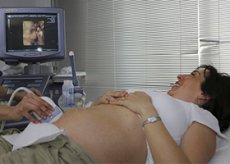Medical expert of the article
New publications
Scientists have disproved the impact of ultrasound on the development of autism in children
Last reviewed: 02.07.2025

All iLive content is medically reviewed or fact checked to ensure as much factual accuracy as possible.
We have strict sourcing guidelines and only link to reputable media sites, academic research institutions and, whenever possible, medically peer reviewed studies. Note that the numbers in parentheses ([1], [2], etc.) are clickable links to these studies.
If you feel that any of our content is inaccurate, out-of-date, or otherwise questionable, please select it and press Ctrl + Enter.

The emergence of such a pathology as autism has been associated with a variety of factors. And not every one of these factors actually influences the development of the disease. For example, scientists have recognized the fact that autism is associated with the introduction of vaccines as a misconception - this assumption was debunked long ago, but many parents still believe the opposite.
The next common misconception is that the violation of the authentic sphere occurs due to frequently repeated episodes of ultrasound examinations, which are carried out on expectant mothers during pregnancy. From year to year, women are advised to undergo this ultrasound procedure more and more often. Medicine even offers special portable ultrasound devices that can be used even outside a hospital or clinic - for example, at home. Increased interest in ultrasound examinations coincided with an increase in the number of children with autism. Most likely, this was the reason for the emergence of corresponding conclusions: many people began to believe that it was ultrasound that was "to blame" for the development of pathology.
Scientists from the Boston University College of Medicine tried to answer the question of whether such a connection exists. Researchers led by Paul Rosman analyzed medical records of four hundred children. Some children were completely healthy, others were diagnosed with various neurological disorders, and others suffered from autism.
Scientists calculated the number of ultrasound examinations that were performed on the mothers of these children during pregnancy. It was found that the mothers of children with autism underwent the procedure approximately six times. The duration of each ultrasound procedure was almost the same. The only difference was the following: if the ultrasound flow penetrated deep into the tissues of the fetus, then autism appeared in the children born somewhat more often.
At the same time, pediatric experts who reviewed the scientific work expressed complete confidence that the difference in the depth of the ultrasound flow could not cause the development of such a serious disorder as childhood autism.
Most scientists are sure that multiple ultrasound procedures are not capable of giving an impetus to the development of either autism or any other pathologies. But the benefits of such studies are more than convincing. This method allows us to determine low attachment of the placenta, polyhydramnios and oligohydramnios, various fetal pathologies. Ultrasound often allows us to avoid a number of problematic situations, and in some cases, even save the life of a woman and her future child. Such cases include a frozen pregnancy, detachment of a normally located placenta, abnormal presentation of the fetus, and umbilical cord entanglement.
Experts insist: there is no reason to be "afraid" of ultrasound. And if there are doubts, it is better to consult with a doctor you can trust.
More details about the scientists' work can be found on the website http://www.bumc.bu.edu/


 [
[